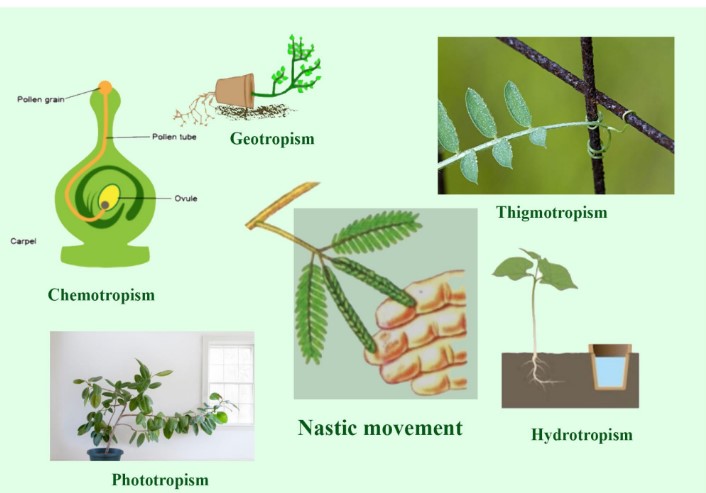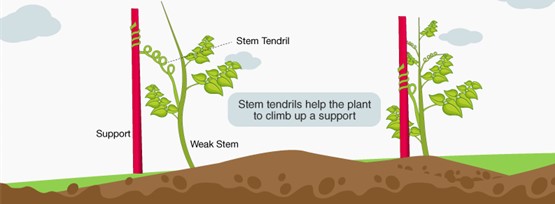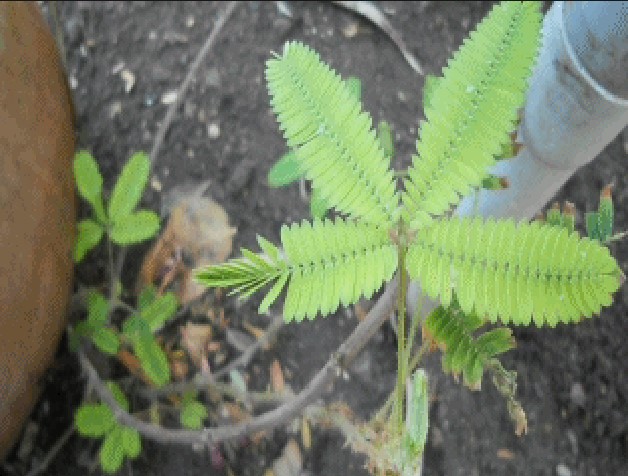Plants, unlike animals, cannot move from one location to another, yet they exhibit remarkable movements in response to environmental stimuli. These movements are crucial for their survival, aiding in everything from capturing prey to maximizing sunlight exposure. Among these, thigmotropism and thigmonasty stand out for their unique responsiveness to touch and pressure, playing pivotal roles in the way plants interact with their surroundings.
Thigmotropism is a directional growth movement in which a plant part moves or grows in response to touch or physical contact. On the other hand, thigmonasty refers to a non-directional movement triggered by touch, which occurs irrespective of the direction of the stimulus. These mechanisms enable plants to navigate their physical environment, whether by clinging to structures for support or swiftly closing leaves to deter predators or conserve water.
The exploration of thigmotropism and thigmonasty unveils a fascinating aspect of plant biology, demonstrating the complexity and sophistication of plant responses to touch. These movements are not mere curiosities but are essential for the survival and reproduction of many plant species. Through understanding these processes, we gain insight into the adaptive strategies plants employ to thrive in diverse and sometimes challenging environments.

Plant Movement Basics
Types of Movements
Plants, though rooted, exhibit a variety of movements. These movements are classified into two main types: tropisms and nastic movements. Tropisms are directional movements that occur in response to an external stimulus, such as light, gravity, or touch. The direction of growth is dependent on the direction of the stimulus. Nastic movements, on the other hand, are non-directional. They occur in response to stimuli like temperature and touch but do not depend on the stimulus’s direction.
Significance in Nature
Plant movements play a crucial role in survival and adaptation. Through these movements, plants can optimize their exposure to vital resources, evade predators, and propagate their species. For example, sunflowers exhibit phototropism by bending towards the light, maximizing photosynthesis. Similarly, the folding of leaves in some plants during rain or night, known as nyctinasty, helps prevent water loss and protects against potential harm.
Examples from Nature
- Sunflowers turning towards the sun (phototropism)
- Mimosa pudica (touch-me-not plant) folding its leaves upon touch (thigmonasty)
- Roots growing downwards, guided by gravity (gravitropism)
Thigmotropism Explained
Definition
Thigmotropism is a type of tropism where plants respond to mechanical stimuli, such as touch or pressure. This response leads to growth towards or away from the stimulus. It is a critical mechanism for plants that need physical support to grow, like vines and climbers.
How It Differs From Other Tropisms
Thigmotropism is unique because it is triggered by physical contact. While other tropisms, like phototropism and gravitropism, respond to light and gravity, thigmotropism requires tangible interaction. This specificity makes it essential for the plant’s physical anchoring and exploration of its surroundings.
Mechanism
The biological process behind thigmotropism involves the perception of touch by sensory cells, leading to a cascade of cellular and biochemical responses. Auxin, a plant hormone, plays a pivotal role in this process. Upon sensing touch, auxin is redistributed in the plant, causing differential growth rates that lead to bending or curving towards the stimulus.
Examples in Nature
- Climbing vines using tendrils to grasp onto supports
- Roots navigating around obstacles in the soil
The sensory mechanisms in roots are particularly fascinating. They can “feel” their way through the soil, avoiding hard objects and growing towards areas with water and nutrients.
Thigmonasty Unveiled
Definition
Thigmonasty is a type of nastic movement that occurs in response to touch or vibration. Unlike thigmotropism, thigmonasty is not directional; the movement happens irrespective of the stimulus’s direction. This rapid movement helps protect the plant or aids in its reproductive efforts.
Distinguishing Features From Other Nastic Movements
What sets thigmonasty apart is its trigger—touch or mechanical disturbance—and its swift response. Other nastic movements might be triggered by changes in light, temperature, or chemical gradients but do not necessarily respond as quickly as thigmonastic movements do.
Mechanism
The trigger and action mechanism of thigmonasty involve changes in cell turgor pressure, which leads to rapid movement. Upon touching, cells on one side of the plant structure release ions, causing water to flow out and the cells to collapse. This action leads to the rapid folding or closing of the plant part involved.
Examples in Nature
- Venus flytrap snapping shut to capture prey
- Mimosa pudica leaves folding upon touch
These rapid responses to touch are not just remarkable adaptations for survival but also highlight the complexity of plant sensory and response systems.

Comparative Analysis
Key Differences
Response Triggers
Thigmotropism is activated by physical contact or pressure, crucial for plants seeking support or navigating their environment. Thigmonasty, conversely, is triggered by a rapid touch or mechanical disturbance, leading to immediate movement, often for defense or prey capture.
Speed and Nature of Movement
Thigmotropism involves slower, growth-related movements towards or away from a stimulus. Thigmonasty, on the other hand, showcases quick, reversible actions that do not depend on the growth but on cellular changes causing movement.
Underlying Mechanisms
The mechanism behind thigmotropism is the redistribution of growth hormones, such as auxin, leading to differential growth rates. Thigmonasty relies on changes in cell turgor pressure, enabling rapid movements without growth.
Similarities
Role in Plant Adaptation and Survival
Both movements enhance survival and adaptation. Thigmotropism aids in finding support and maximizing resource acquisition, while thigmonasty protects against herbivory and aids in prey capture.
Dependence on External Stimuli
Thigmotropism and thigmonasty are both dependent on external stimuli (touch), showcasing plants’ dynamic responses to their environment, highlighting their sensitivity and adaptability.
Impact on Ecosystems
Ecological Significance
Importance in Pollination and Seed Dispersal
Movements like thigmonasty in flowers can facilitate pollination by ensuring that pollinators come into effective contact with reproductive parts. Thigmotropism in climbing plants can lead to seed dispersal by enabling plants to grow into positions where seeds can be more effectively spread by wind or animals.
Contribution to Biodiversity
By enabling plants to occupy diverse ecological niches and interact with a variety of pollinators and animals, these movements increase biodiversity. Diverse plant behaviors can support a wider range of animal species, contributing to healthier ecosystems.
Adaptation Strategies
Evolution of Movement Mechanisms
Plants have evolved sophisticated movement mechanisms as adaptive strategies to survive in competitive and often hostile environments. These movements allow plants to maximize resource acquisition, evade predators, and reproduce effectively.
Interaction with Environment and Species
Thigmotropism and thigmonasty facilitate complex interactions with the environment and other species, including symbiotic relationships with pollinators and protective measures against herbivores. These interactions are essential for the balance and sustainability of ecosystems.
Future Research Directions
Current Studies
Ongoing research in plant movement is uncovering the genetic and molecular bases of these fascinating behaviors. Scientists are exploring how plants perceive touch and translate it into growth or movement, with implications for understanding plant-environment interactions more deeply.
Technological Advancements
Recent technological advancements, such as high-resolution imaging and genetic engineering, are opening new avenues for studying plant movements. These tools allow for the visualization of cellular processes in real-time and the manipulation of genes responsible for movement responses.
Potential Applications
Agriculture and Horticulture
Understanding plant movements can lead to innovations in crop production and garden design. For example, insights into thigmotropism could improve the support systems for climbing plants, while understanding thigmonasty could inform pest control strategies.
Environmental Conservation
Knowledge of how plant movements contribute to ecosystem health can inform conservation strategies. Protecting plant species that play key roles in their ecosystems, thanks to their movement capabilities, can help maintain biodiversity and ecosystem services.

FAQs
What is Thigmotropism?
Thigmotropism is a plant’s growth movement in response to a touch or physical contact stimulus. It enables parts of the plant, such as tendrils and roots, to grow towards or away from the stimulus, aiding in support and nutrient acquisition. This growth mechanism is pivotal for climbing plants and for root systems as they navigate through soil environments to anchor the plant and seek water and nutrients.
How does Thigmonasty differ from Thigmotropism?
Thigmonasty differs from thigmotropism in its non-directional nature. While thigmotropism involves growth toward or away from a touch stimulus, thigmonasty results in a rapid movement that is not dependent on the direction of the stimulus. This mechanism is seen in plants like the Venus flytrap, which closes its leaves in response to touch, and the touch-me-not plant, which folds its leaves to protect itself.
Why are Thigmotropism and Thigmonasty important?
Thigmotropism and thigmonasty are vital for plant survival and adaptation. Thigmotropism allows plants to seek support and maximize exposure to essential resources like light and water, while thigmonasty helps protect against herbivory and aids in seed dispersal. These movements contribute to the ecological success of plants, allowing them to adapt to their environments, interact with other organisms, and ensure their reproduction and survival.
Conclusion
The phenomena of thigmotropism and thigmonasty showcase the intricate and dynamic ways in which plants interact with their environment. Through these movements, plants not only ensure their survival and reproduction but also contribute to the richness and diversity of ecosystems. Understanding these processes illuminates the adaptive strategies plants have evolved, revealing the complexity of life even in what may seem like passive organisms.
As we continue to explore the natural world, the study of plant movements such as thigmotropism and thigmonasty offers valuable insights into the resilience and adaptability of plants. These mechanisms underscore the importance of considering plants as active participants in their ecosystems, capable of sophisticated responses to environmental challenges. Such knowledge not only deepens our appreciation of plant biology but also highlights the interconnectedness of all life forms.

